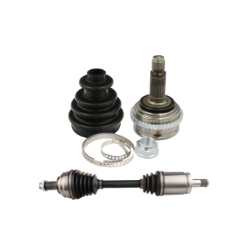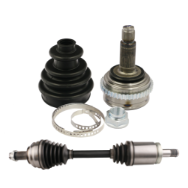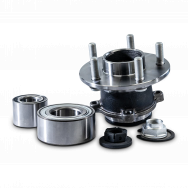Select your vehicle
Car Selector
Quick Pick
Know the part number? Enter it below with the required quantity:
Transmission

Shop replacement transmission parts online
The transmission system is one of the most vital pieces in a car engine. It’s also known as a gearbox, although not all vehicles have gears. Transmission transmits power from the engine to the wheels and controls the engine speed in accordance with the driver’s needs.
Transmission parts can wear over time, affecting power, performance, and safety. Without a transmission system, an engine would quickly shake or overheat, and the driver would have less control over the vehicle. It’s important that your transmission receives regular maintenance and parts are replaced when needed.
NAPA Auto Parts is your one-stop solution for aftermarket transmission parts online. Search the make, model, and/or reg of your car using our VRM Look Up to discover the right parts for your vehicle — or browse by part.
With next-day delivery*, NAPA Auto Parts is committed to getting you back on the road as soon as possible.
How does the transmission system work?
The transmission system transmits power from the engine to the wheels and changes gears according to the vehicle’s speed and accelerator input. Low gears transmit a high power to get the car moving while high gears transmit less power at a higher speed, allowing the car to move faster. This protects your engine and reduces your fuel usage.
In a manual transmission system, the clutch pedal is pressed to disengage the gearbox from the engine. The driver can then use the gear lever (gear stick) to select which gears will connect. With the gearbox leading to the car’s differential, it’s then able to push the torque through to the wheels.
In an automatic transmission system, there’s no clutch pedal. Sensors, processors, and actuators measure your current speed and accelerator force so the transmission can automatically implement the clutch and change gears. The gear stick allows the driver to choose between Drive, Reverse, Park, and Neutral.
To then deliver the power to the wheels, front-wheel drive vehicles use constant velocity (CV) shafts, which utilise CV joints and boots. Rear-wheel drive vehicles use drive shafts (also known as a prop shaft), which utilise universal joints (or U-joints). Four-wheel and all-wheel drive vehicles may use either kind of shaft.
There are variants of both manual and automatic transmission systems.
In manual, dual-clutch or double-clutch transmissions were common in older cars, with one clutch operating even gears and the other operating odd gears. A synchronised or constant mesh transmission eliminates the need for dual-clutch by keeping the cluster gear, drive gear, and mainshaft gear constantly moving.
In automatic, a common type is torque convertor transmissions. Gears are changed using hydraulics, producing a smooth shift. Meanwhile, continuously variable transmissions (CVT) use a system of belts and cones instead of the usual cogs. As the speed of the vehicle changes, the belts move up and down the cones to continuously locate the best gear for the current circumstances.
Semi-automatic transmission systems include the automated manual transmission, dual-clutch automatic transmission, DSG transmission, and sequential transmission.
What are the 9 most common signs of transmission failure?
The components within a car transmission system frequently endure intense pressure and extreme temperatures, leading to wear and potential damage over time. This system should be inspected with regular servicing so components can be replaced when they show signs of wear. Knowing the symptoms of a failing transmission can keep you (and your wallet) safe from bigger damage.
Here are 9 common signs of transmission problems:
1. High resistance to changing gears. If your vehicle struggles to switch gears, or even jumps out of gear, it’s almost certainly a transmission problem. This could be caused by low transmission fluid.
2. Delayed or no response when changing gears. If you experience a delayed response or no response when switching gears, this indicates a transmission fault.
3. Burning smell. A burning smell inside your car without smoke or fire could indicate that the transmission fluid is old or overheating, which can lead to premature wear or corrosion of the engine.
4. Dragging clutch. This could feel like hard shifting, jerky vehicle movement when starting, gears clashing, or potentially even the engine stalling. Clutch drag occurs when the clutch disc and flywheel aren’t correctly disengaging when the clutch pedal is used. There can be a few possible causes but it’s most likely the result of a mechanics failure, like a faulty clutch cable.
5. Noises from the gearbox.
- Sudden loud whining. A whining noise that starts suddenly and gets loud can be a sign of corrosion of the gear hub bearings or gear teeth. This is most likely caused by insufficient lubrication but even if the transmission fluid is replaced, the damage will persist. Regular oil changes can prevent this before it occurs.
- Humming noise. A humming noise can indicate low or contaminated transmission fluid, a worn or corroded shaft, or a bad wheel bearing.
- Growling or rumbling noise. Low rumbling or growling noises can indicate a problem with the ball bearings. If left unchecked, the rumbling will likely get louder as time passes until the bad wheel bearing eventually breaks.
- Clicking noise. Like whining, a clicking noise may be caused by damaged gear teeth within the gearbox.
- Clunking or banging noise. If you hear a thudding, clunking, banging noise when changing gear, it’s likely that your vehicle has a loose or broken drive shaft or transmission mount.
6. Grinding, crunching, or shaking gears. Typically both a sound and a feeling, if you experience grinding, shaking, or crunching when changing gears, this is a definite sign that your transmission is faulty. It could be anything from low gearbox oil, to worn linkage, to broken components.
7. Transmission fluid leak. Transmission fluid is typically a sweet-smelling red liquid (though sometimes brown) so it should be easy to identify if you spot a pool underneath your car. It’s important to repair the source of the leak before topping up the oil level. Similarly, grease on the wheels could indicate a leaking CV boot.
8. Slipping gears. You may notice your gears are slipping when the engine revs while switching gears or if you feel like you’re driving on ice. This is a sure sign of worn or damaged transmission parts. Driving with slipping gears is highly dangerous, so pull over as soon as you can and take your vehicle to a professional.
9. The check engine light on your dashboard is on. The check engine light can be triggered for a variety of problems, including transmission faults. Your vehicle should be inspected by a professional as soon as possible.
Transmission components are critical to your safety on the road. When experiencing any of these problems, it’s vital that your car is serviced by a mechanic as soon as possible.
It’s not common for the transmission to fail with no warning signs, but if you experience total transmission failure while driving, don’t panic. Activate your hazard lights and pull over as soon (and as safely) as you can. If possible, engage the emergency hand brake.
Transmission failure will affect the car’s ability to communicate with the engine. This is why a vehicle that has experienced complete or partial transmission failure should not be driven until the parts have been repaired or replaced. NAPA Auto Parts makes all efforts to deliver your replacement parts as fast as possible to get your vehicle back on the road.
How often should transmission parts be replaced?
Both manual and automatic transmission components are highly durable and can last 150,000–200,00 miles (or longer!) with proper care. Accelerating quickly and braking hard can put unnecessary stress on your transmission, so be mindful to maintain good driving habits.
For the health of the more expensive components, it’s recommended that the transmission fluid and filter should be changed every 30,000–60,000 miles, and the transmission should be flushed every 2 years to clear out debris.
Adjacent to the transmission, the technician should also be correctly torquing the wheels whenever they are removed or replaced. Incorrectly torqued lug nuts on a vehicle’s wheels can harm the function of the transmission and braking systems.
Always check the advice provided by the relevant manufacturer and ensure your vehicle is serviced regularly. For your safety, the transmission system should be inspected for signs of wear at every oil change and service.
How much does it cost to replace transmission parts?
The price of replacement transmission parts in the UK can vary depending on brand, quality, and the products required, with a new gearbox likely running into the thousands. Some parts have a higher replacement cost than others, but NAPA Auto Parts is committed to bringing you great quality at affordable prices.
Save on a growing catalogue of gearboxes, gears, gear linkage and rods, drive shafts, CV joints and boots, wheel bearings, manual and automatic locking hubs and hub caps, nuts and bolts, and more with NAPA Auto Parts UK.
*Limitations apply.



